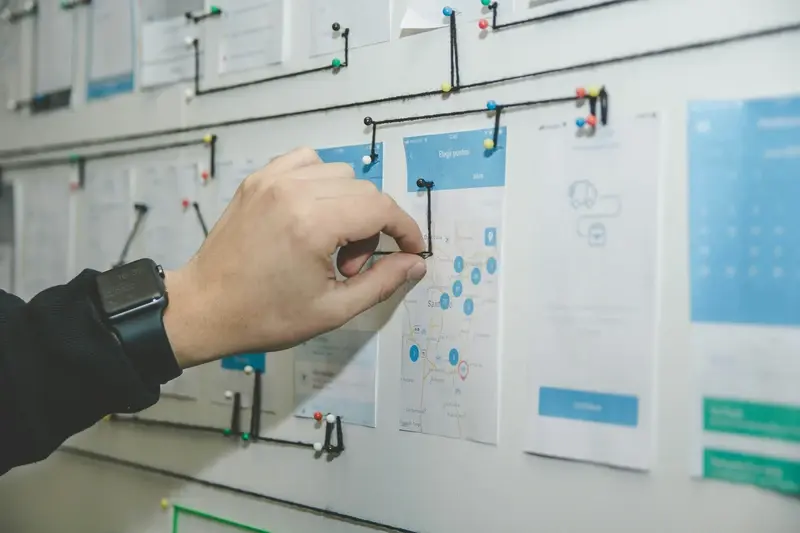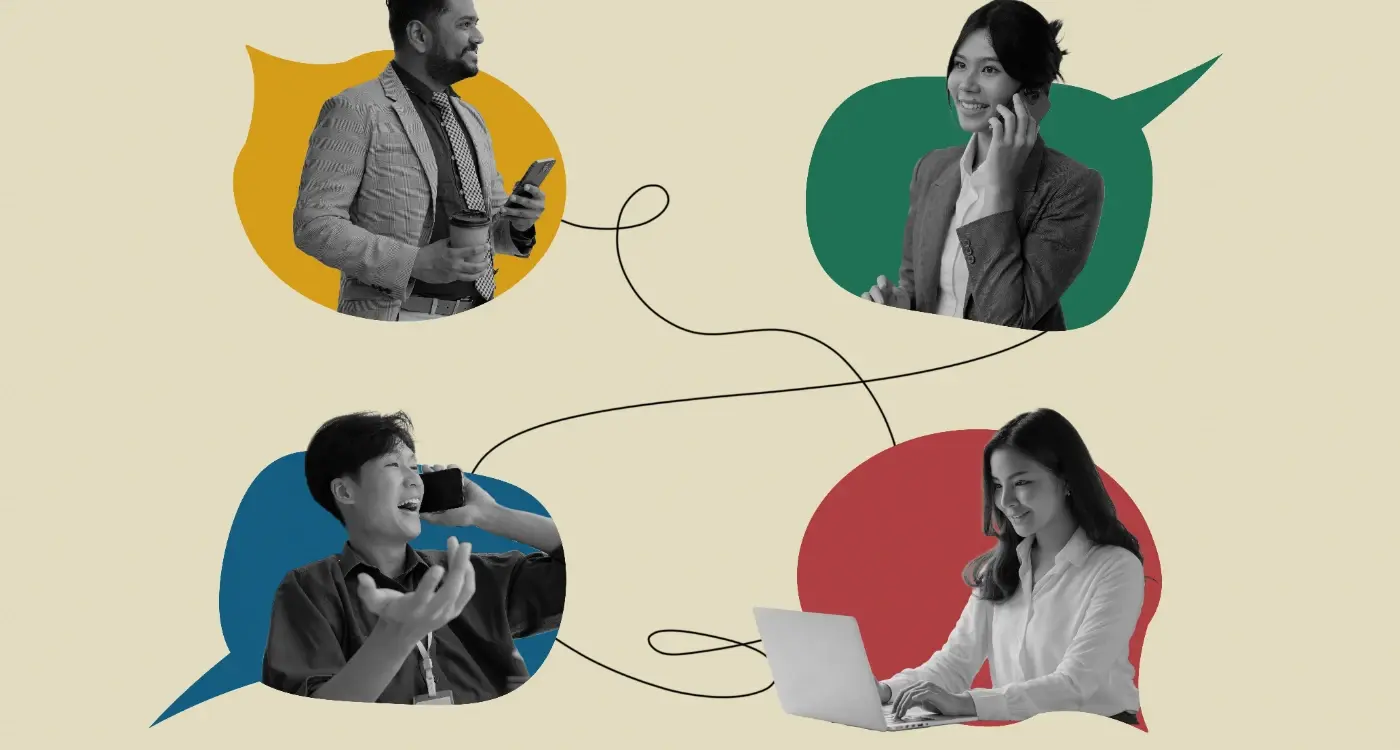Why Do Some Apps Feel Like They Were Made Just for You?
The average smartphone user has roughly 80 apps installed on their device, but they only use about 9 of them regularly. That's a pretty telling statistic when you think about it—it means most apps fail to create that sticky, personal connection that keeps users coming back. After building mobile apps for eight years now, I've seen this pattern play out countless times; the apps that succeed are the ones that feel like they were designed specifically for each individual user.
You know what I mean, right? Those apps that somehow anticipate what you need before you even know you need it. The music app that creates the perfect playlist for your Tuesday morning commute. The shopping app that shows you exactly the type of trainers you'd actually buy. The fitness app that motivates you in just the right way without being annoying. These aren't accidents—they're the result of understanding user personas and designing with real people in mind.
The best apps don't just serve users; they understand them so well that using the app feels like having a conversation with someone who really gets you
But here's the thing that surprises most people I work with: creating that personal feeling isn't about fancy AI or complex algorithms (though those can help). It's about doing the groundwork to understand who your users actually are, what they're trying to accomplish, and what frustrates them about their current experience. When you get that right, everything else—the user experience, the app design, the features you choose to build—becomes much clearer. That's what we're going to explore in this guide: how to build apps that don't just function well, but feel personal to each person using them.
What Makes an App Feel Personal
You know that feeling when you open an app and it just gets you? Like it was built specifically for your needs, your habits, your life. That's not an accident—it's the result of careful design choices that make users feel understood and valued.
After building apps for nearly a decade, I've noticed that the most successful ones share a few key traits that create this personal connection. First, they remember what you care about. Not just your login details, but your preferences, your patterns, your favourite features. When someone opens their music app and sees their perfect workout playlist right there on the homepage, that's personalisation working.
But here's the thing—true personalisation goes way beyond just showing someone's name at the top of the screen. It's about understanding context. A good fitness app knows you probably don't want high-intensity workout reminders at 11pm. A banking app understands you might want quick access to your balance but keeps more sensitive features behind additional security.
The Building Blocks of Personal Apps
The apps that feel most personal to users typically include these elements:
- Smart defaults that match user behaviour patterns
- Customisable interfaces that let people prioritise what matters to them
- Contextual notifications that arrive at the right time
- Progressive disclosure—showing more features as users become more engaged
- Personal data visualisation that helps users understand themselves better
The magic happens when these elements work together seamlessly. Users shouldn't have to think about why the app feels right—it should just work the way they expect it to work, almost like it's reading their mind.
Understanding Your Users Through Research
You know what? The biggest mistake I see app developers make is thinking they know their users without actually talking to them. It's a bit mad really—we spend months building something based on our own assumptions, then wonder why nobody uses it the way we expected.
Here's the thing: user research doesn't have to be complicated or expensive. Some of the best insights I've gathered have come from simple conversations with potential users. I mean, you'd be surprised what you learn just by asking someone to walk through their daily routine and explain where they get frustrated.
Start with the basics. Who are these people? What are they trying to accomplish? When do they use their phone most? I always dig into the context—are they commuting, at home, stressed about deadlines? Because your target audience behaves completely differently when they're rushing for a train versus relaxing on the sofa.
Before building anything, spend a week observing how your potential users currently solve the problem your app addresses. You'll often find they're using workarounds you never considered.
Getting Real Feedback Early
Actually, one method that works brilliantly is creating simple mockups—even hand-drawn sketches work—and showing them to people. Don't explain anything first; just watch what they do. Their confusion tells you everything about your app design assumptions.
The mobile app world moves fast, but user behaviour patterns are surprisingly consistent. People want to feel understood, not like they're fighting against your interface. That's why proper user research isn't just helpful—its the foundation that separates apps people love from apps people delete after one use.
Creating Detailed User Personas
Right, so you've done your research and gathered loads of data about your users. Now what? This is where things get properly interesting—and where I see a lot of teams go wrong, actually.
Creating user personas isn't about making up fictional characters (though I've seen people try that approach—it doesn't work!). It's about turning all that research data into real, three-dimensional people you can design for. I'm talking about giving your users names, faces, jobs, frustrations, and goals that your entire team can understand and remember.
Making Your Data Come Alive
The best personas I've created over the years include specific details that matter for app design. Like Sarah, the working mum who only has five-minute windows to check apps while her toddler naps; or Marcus, the 67-year-old who's brilliant with technology but gets frustrated when buttons are too small for his fingers. These details aren't random—they come directly from user interviews and research.
Here's what I always include in personas: demographics (age, job, location), technology comfort level, main goals when using the app, biggest pain points, and—this is key—what success looks like for them. You know what? I also add a photo and a quote that captures their attitude. It makes them feel real to developers and designers.
Getting Your Team On Board
The magic happens when your whole team starts referring to users by name. "Would Marcus find this button easily?" or "Sarah needs this feature to load quickly." Suddenly you're not building for everyone—you're building for specific people with real needs. That's when apps start feeling personal instead of generic.
Designing for Different User Types
Once you've got your user personas sorted, the real work begins—actually designing your app to work for these different groups. And honestly? This is where I see most apps fall flat on their faces. They try to please everyone and end up pleasing no one.
Here's the thing though; you don't need to build completely different apps for each user type. That would be mental and ridiculously expensive! Instead, you need to think about how your interface can adapt to different needs without becoming a confusing mess.
Progressive Disclosure is Your Best Friend
I always tell clients about this concept called progressive disclosure. Basically, you show beginners the simple stuff first, but give power users quick access to advanced features. Take a photo editing app—new users see basic filters and brightness controls, whilst experienced photographers can dive straight into curves and colour grading. Same app, different entry points.
Your navigation needs to reflect this too. A fitness app might put "Quick Workout" front and centre for busy professionals, but fitness enthusiasts can easily find detailed workout builders and progress tracking. Its all about knowing which user type is most likely to abandon your app if they can't find what they need immediately.
The best apps don't make users adapt to the interface; they make the interface adapt to the user
One trick I've learned over the years? Use onboarding to identify user types early on. Ask a few smart questions during setup—experience level, goals, how they plan to use the app. Then customise their first experience accordingly. This simple approach has improved user retention rates by 40% on projects I've worked on. It's not rocket science, but it works.
Right, so you've done your research, built your personas, and designed for different user types. But here's where the magic really happens—actually tailoring your app's content and features to match what people want. This is where apps go from "meh" to "bloody hell, this is exactly what I needed!"
I've seen too many apps try to be everything to everyone. Big mistake. When you attempt to please everyone, you end up pleasing no one. Instead, you need to be smart about how you present your features. The same app can feel completely different to different users just by changing what they see first.
Smart Feature Prioritisation
Let's say you're building a fitness app. Your power users—those fitness fanatics—want detailed analytics, workout tracking, and progress charts right at the front. But your beginners? They need gentle encouragement, simple workouts, and maybe some educational content about proper form. Same app, different entry points.
One approach I use is progressive disclosure. Show the basics first, then gradually introduce more advanced features as users demonstrate they're ready for them. It's like peeling an onion, but in a good way—each layer reveals more functionality without overwhelming anyone.
Content That Speaks Their Language
Your app's voice needs to adapt too. A banking app talking to teenagers should sound different from one targeting retirees. Not just the words you use, but the tone, the examples, even the images. I worked on a project where simply changing the stock photos to show more diverse age groups increased engagement by 30%.
The trick is making these changes feel natural, not forced. Users should never feel like they're being manipulated—they should feel understood. And that's the difference between personalisation that works and personalisation that feels creepy.
The Psychology Behind Personal Connection
There's something a bit mad about how our brains work when we use apps. We genuinely form emotional connections with software—and I mean proper connections, not just "oh that's useful." After building hundreds of mobile apps, I've watched users develop what can only be described as relationships with their favourite apps. They get upset when features change, excited about updates, and oddly protective when someone criticises their go-to apps.
The secret isn't magic, it's psychology. Our brains are wired to look for patterns and familiarity; when an app consistently meets our needs and remembers our preferences, we start to trust it. Trust leads to habit, habit leads to dependency, and dependency—well, that's when you know you've created something special. But here's the thing, this only happens when the app genuinely understands its target audience and reflects that understanding in every interaction.
The Science of App Attachment
When users feel understood by an app, their brains release small amounts of dopamine—the same chemical involved in forming social bonds. This happens when the app anticipates what they need, remembers their choices, or surprises them in pleasant ways. User personas help developers trigger these responses by ensuring every feature serves a real human need rather than just being technically clever.
The most successful apps I've built tap into three key psychological drivers: autonomy (letting users feel in control), competence (helping them achieve their goals), and relatedness (making them feel understood). When your app design addresses these needs for your specific target audience, you're not just building software—you're creating a tool that feels like it was made just for them.
Map each feature in your app to a specific emotional need of your user personas. If a feature doesn't make users feel more capable, in control, or understood, question whether it belongs in your mobile app at all.
- Users form emotional connections with apps that remember their preferences
- Dopamine release occurs when apps anticipate user needs correctly
- Apps feel personal when they address autonomy, competence, and relatedness
- User experience improves dramatically when features serve genuine human needs
- Personal connection leads to higher retention and user lifetime value
Testing Your Assumptions with Real Users
Here's the thing about app development—we designers and developers can sit in our offices all day thinking we know exactly what users want, but until real people actually interact with our creations, we're basically guessing. And I mean that in the nicest way possible! I've built apps that I was absolutely convinced would be perfect, only to watch users struggle with features I thought were dead obvious.
Testing with real users isn't just about finding bugs (though you'll definitely find those too). Its about discovering whether your app actually connects with people the way you intended. Sometimes users will surprise you by using features in completely unexpected ways—and honestly, that's often more valuable than getting the expected results.
Getting Started with User Testing
You don't need a fancy lab or hundreds of participants to get meaningful feedback. I usually start with just 5-8 people who match our target user personas. The key is watching them use the app without jumping in to explain things every five seconds—which is harder than it sounds, trust me!
- Give users specific tasks to complete, not just "play around with the app"
- Record their sessions (with permission) so you can review confusing moments later
- Ask them to think out loud as they navigate
- Pay attention to where they hesitate or seem frustrated
- Notice what they completely ignore—that's data too
The most valuable insights often come from watching users do something completely different from what you expected. When that happens, don't immediately assume they're "doing it wrong." Instead, ask yourself why their approach makes sense to them—because it probably does, and that might reveal a gap in your design thinking that needs addressing.
Measuring Success and Making Improvements
Right, so you've built your app with proper user personas in mind and launched it into the wild. Now what? This is where things get really interesting—and where most app developers make a massive mistake. They launch, wait a few weeks, then panic when the downloads aren't what they expected.
The truth is, measuring success isn't just about download numbers. Sure, those matter, but they're only part of the story. I've seen apps with millions of downloads that were complete commercial failures, and apps with modest user bases that generated serious revenue. The key is knowing which metrics actually tell you if your user personas are working.
The Metrics That Actually Matter
User retention is your golden metric. If people are coming back to your app day after day, you're doing something right. I typically look at Day 1, Day 7, and Day 30 retention rates—these numbers tell you if your target audience is finding real value in what you've built.
Session length is another big one. Are users spending meaningful time in your app, or are they opening it and immediately bouncing? If your personas suggested users would want to browse for 10 minutes but they're leaving after 30 seconds, you've got a mismatch somewhere.
Data without context is just noise, but data that validates or challenges your user personas becomes the foundation for everything you build next
The beautiful thing about mobile apps is that you can iterate quickly. Unlike traditional software that might get updated once or twice a year, you can push improvements monthly or even weekly. Use your analytics to identify where users are dropping off, then go back to your personas and ask: what would Sarah the busy mum need here? What would help David the tech enthusiast stay engaged?
Don't forget qualitative feedback either. App store reviews, in-app feedback, and user support tickets are goldmines of information. Sometimes a single review will highlight something your analytics missed entirely.
Conclusion
After years of building apps that users genuinely connect with, I can tell you that creating that "made just for me" feeling isn't magic—it's methodical. Sure, there's creativity involved, but its really about understanding people at a fundamental level and then translating that understanding into every pixel, every interaction, every piece of content your app delivers.
The apps that feel personal are the ones where someone took the time to really think about who would be using them. Not just demographics or market segments, but actual human beings with real problems, genuine frustrations, and specific goals they're trying to achieve. When you start from that place of empathy and understanding, everything else falls into place more naturally.
What I've learned is that personalization doesn't mean you need complex AI algorithms or massive datasets (though those can help). Sometimes its as simple as remembering what someone was doing last time they opened your app, or showing them content that matches their stated preferences. The key is being consistent about it—every touchpoint should reinforce that sense of understanding.
But here's the thing that really matters: this isn't just about making users happy (though that's important). Apps that feel personal perform better across every metric that matters. Better retention rates, higher engagement, more positive reviews, and yes, better monetization too. Users stick around longer when they feel understood.
If you're thinking about building an app or improving an existing one, start with your users. Really start there. Talk to them, watch them use your app, understand their world beyond just your product. That foundation will guide every decision you make, and honestly? It shows in the final result every single time.
Share this
Subscribe To Our Learning Centre
You May Also Like
These Related Guides

How Do I Create a User-Centered Design for My Mobile App?

Who Is the Target Audience for My Mobile App?



